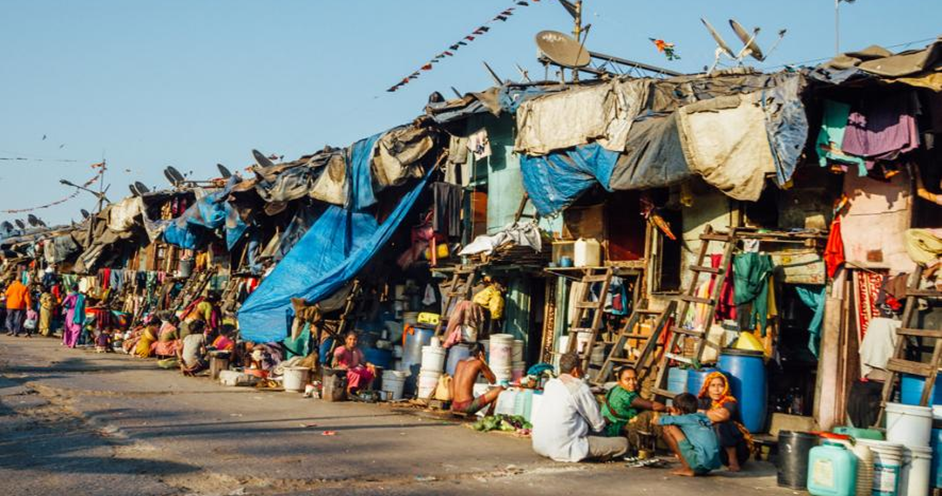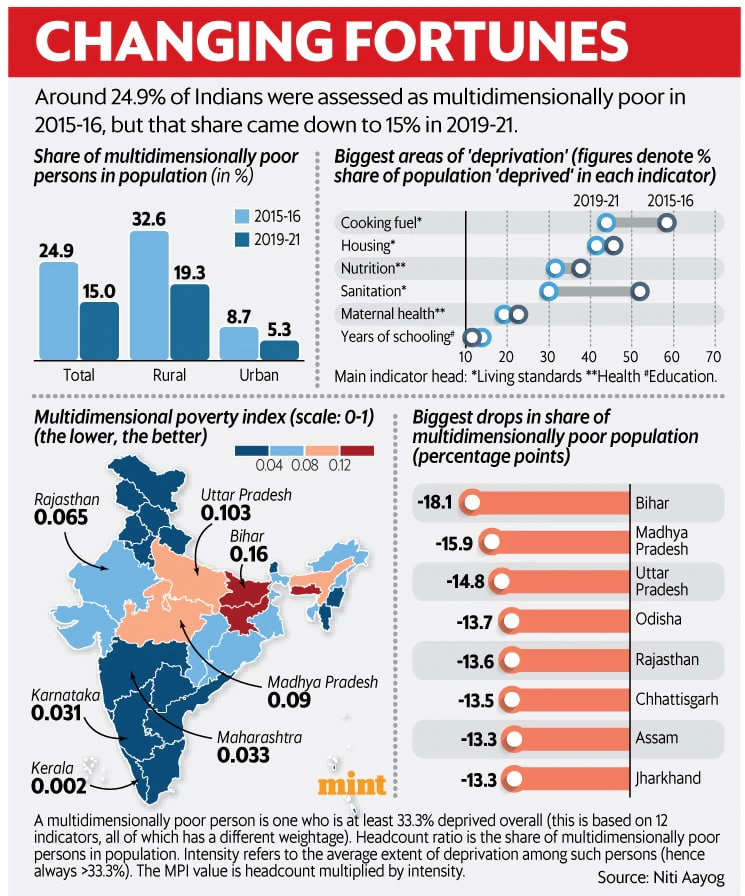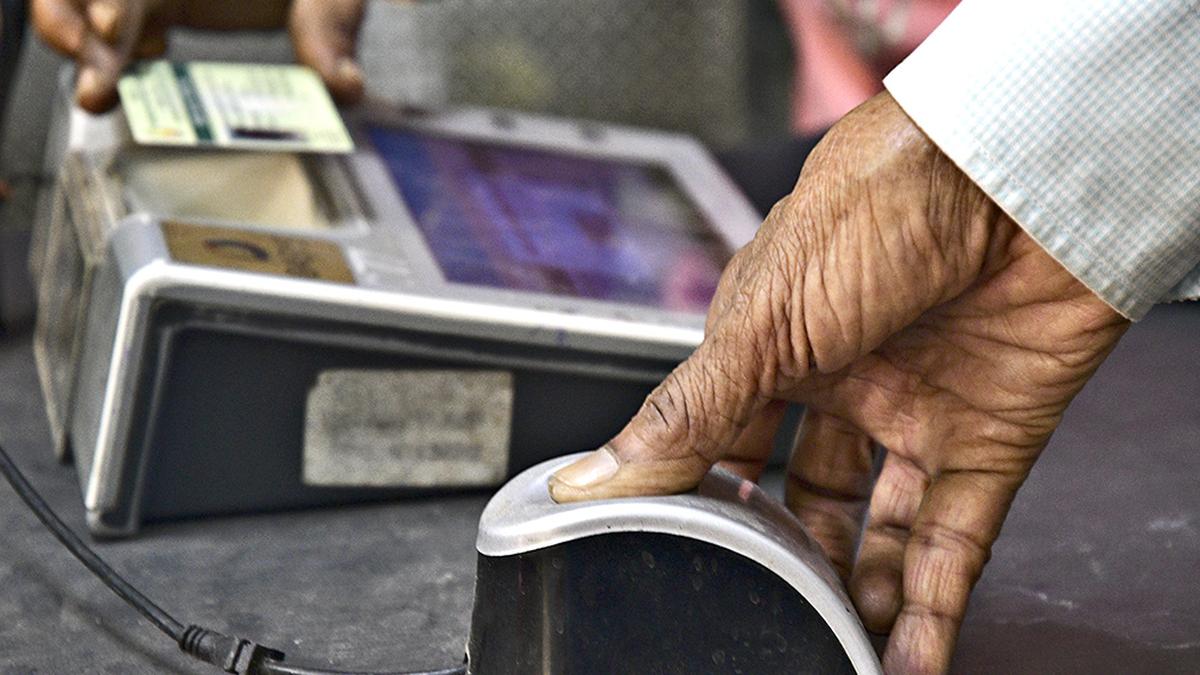Description

Copyright infringement not intended
Context: According to a report by the Niti Aayog, India has made remarkable progress in reducing multidimensional poverty in the last four years. The report, titled 'National Multidimensional Poverty Index: A Progress of Review 2023', was unveiled by the Vice-Chairman of Niti Aayog.
Details
- The report presents the National MPI, a comprehensive measure of poverty that captures multiple deprivations in health, education, and living standards. The indicators used for the National MPI are aligned with the Sustainable Development Goals (SDGs).
Highlights of the Report
- The Niti Aayog report titled 'National Multidimensional Poverty Index: A Progress of Review 2023' revealed that India's multidimensional poverty rate, which measures the deprivations faced by people in health, education and living standards, fell from 24.85% in 2015-16 to 14.96% in 2019-21.
- This means that about 135 million people moved out of multidimensional poverty during this period.
- It highlighted that Uttar Pradesh, Bihar, Madhya Pradesh, Odisha and Rajasthan witnessed the fastest reduction in multidimensional poverty among all states.
- According to the report, poverty in both rural and urban areas declined significantly between 2015-16 and 2020-21. The rural poverty rate fell from 32.59% to 19.28%, while the urban poverty rate dropped from 8.65% to 5.27%.
- The MPI value decreased from 0.117 to 0.066, and the intensity of poverty decreased from 47% to 44%, in the five years. This means that India is on track to achieve the SDG target 1.2 (of reducing multidimensional poverty by at least half) well before the deadline of 2030.
- The report showed that India made significant improvements in all the indicators, especially in nutrition, child mortality, years of schooling, school attendance, cooking fuel, sanitation and electricity. It states that "All 12 parameters of the MPI have shown marked improvements."
- The report attributed this progress to various government schemes and initiatives such as the National Nutrition Mission, Ayushman Bharat, Swachh Bharat Mission, Ujjwala Yojana, Saubhagya Yojana and others.
- The report highlights the importance of using the National MPI as a policy tool to identify and address the multiple dimensions of poverty and inequality in India.
Concern
- The report also highlighted the regional disparities and inequalities in multidimensional poverty across states, districts, social groups and genders.
- It found that Bihar, Jharkhand, Uttar Pradesh and Madhya Pradesh had the highest MPI values, while Kerala, Goa, Delhi and Punjab had the lowest.
- It found that rural areas had a higher MPI than urban areas, Scheduled Tribes had a higher MPI than other social groups, and females had a higher MPI than males.

Why is the MPI important?
- The MPI is important because it provides a more comprehensive picture of poverty than income alone. It helps to identify the multiple and overlapping deprivations faced by poor people and their specific needs and priorities.
- It helps to monitor and evaluate the impact of policies and programs on different dimensions of poverty and well-being.
- It helps to foster accountability and transparency among stakeholders and to promote dialogue and collaboration among different sectors and levels of government.
- The MPI is also important because it aligns with India's vision of achieving inclusive and sustainable development as envisaged in the SDGs. The SDGs aim to end poverty in all its forms and dimensions by 2030 and to ensure that no one is left behind.
- The MPI can help India to track its progress towards these goals and to identify the gaps and challenges that need to be addressed.
What are the challenges and way forward?
- Reducing the regional disparities and inequalities in multidimensional poverty across states, districts, social groups and genders.
- Enhancing the quality and availability of data on multidimensional poverty at more disaggregated levels and more frequent intervals.
- Strengthening the coordination and convergence among different ministries, departments, agencies and stakeholders involved in addressing multidimensional poverty.
- Increasing the awareness and participation of civil society, media, academia and other actors in advocating for and monitoring multidimensional poverty reduction.
- Integrating the MPI into planning, budgeting, implementation and evaluation processes at all levels of government.
- Leveraging innovation, technology, partnerships and best practices to accelerate multidimensional poverty reduction.

Conclusion
- India has made remarkable strides in reducing multidimensional poverty in recent years. However, there is still a long way to go to achieve the SDGs and ensure that no one is left behind. The MPI can serve as a useful tool to guide India's efforts towards this end.
Must-Read Articles:
Multidimensional Poverty Index (MPI): https://www.iasgyan.in/daily-current-affairs/multidimensional-poverty-index-mpi#:~:text=Children%20under%20the%20age%20of,people%20living%20in%20rural%20areas.
NITI Aayog: https://www.iasgyan.in/daily-current-affairs/niti-aayog-14
Poverty: https://www.iasgyan.in/daily-current-affairs/poverty-in-india-4
|
PRACTICE QUESTION
Q. Poverty is one of the most pressing issues in India, affecting millions of people across the country. What are the main causes of poverty in India, and how does it impact the social, economic and environmental aspects of the nation? What are the steps taken by the government to reduce poverty and improve the quality of life of the poor? What are the possible ways forward to eradicate poverty and achieve sustainable development goals in India?
|
https://epaper.thehindu.com/ccidist-ws/th/th_delhi/issues/44078/OPS/GQRBGDM9H.1+GA6BGEL8P.1.html
Array
(
[0] => daily-current-affairs/national-multidimensional-poverty-index-a-progress-review-2023
[1] => daily-current-affairs
[2] => national-multidimensional-poverty-index-a-progress-review-2023
)









